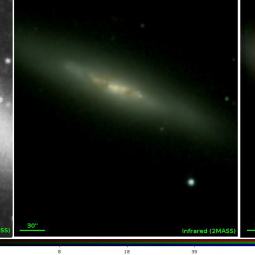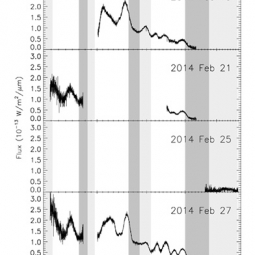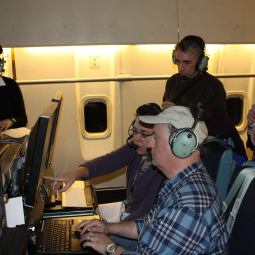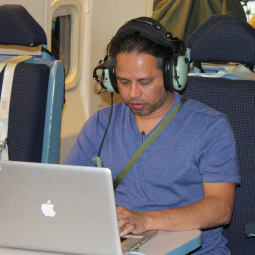On Feb. 18, 20, 24, and 26, NASA's flying observatory focused on the explosion known as a supernova that obliterated the remains of a star about the mass of the Sun in the Messier 82 galaxy (M82). Located 11 million light years from Earth in the direction of the constellation Ursa Major, the exploding star is named Supernova (SN) 2014J.
NASA called upon its Stratospheric Observatory for Infrared Astronomy, SOFIA, to view the supernova using the converted jetliner's 2.5-meter diameter telescope that is optimized for collecting radiation at infrared wavelengths. SOFIA is able to fly above 99 percent of the water vapor in the Earth's atmosphere that blocks most infrared light from being observed by ground-based telescopes.
Supernova 2014J is a Type Ia supernova, known to astronomers as a "standard candle."The power output of a standard candle is well-known. In the same way that you can estimate the distance of a flashlight of known wattage by seeing how bright or faint it appears, astronomical standard candles allow determination of distances to objects that are extremely far away. Type Ia supernovae are the main yardsticks used to measure the expansion of the universe and demonstrate that the expansion is actually accelerating.
Supernovae are also important in a way that's surprisingly relevant to life on Earth; most of the atoms in the universe more massive than iron (such as nickel, lead, gold, silver, and platinum) are made in the incomprehensible heat of supernova explosions. Essentially all the gold or silver you own, and the nickel in the coins in your pocket, was forged originally in supernova explosions that happened long before Earth formed.
"SN 2014J is the brightest and closest Type Ia supernova we've seen in the last 40 years and that's why it's exciting," said Erick Young, science mission operations director from the SOFIA Science Center at NASA Ames Research Center in Moffett Field, Calif. "We have been finishing our last instrument commissioning tests as we prepare to transition from an experimental platform into a fully operational observatory. While we were airborne, we wanted to use Supernova 2014J as a test target. We've taken some very interesting images of the exploding star, but what the scientific community wants to study most is the spectroscopic data we've obtained using the FLITECAM (First Light Infrared Test Experiment CAMera) instrument."
Developed by Professor Ian McLean and his team at the University of California, Los Angeles, FLITECAM is a near infrared camera with spectrographic capabilities. Its near infrared camera detects light in the 1- to 5.2-micron wavelength range. Each element has its own unique spectral signature, which FLITECAM can record using its grism spectrometer. The FLITECAM team is using those data to study infrared spectral lines that cannot be detected from Earth or from any current space observatory.
Astronomers estimate that the first light from the SN 2014J explosion reached Earth during the night of Jan. 14/15, but was first noticed on Jan. 21 by a group of students at the University of London Observatory that included Ben Cooke, Tom Wright, Matthew Wilde, Guy Pollack, and teaching fellow Stephen J. Fossey. In the weeks following its discovery, most telescopes on Earth and in space have observed the exploding star to produce a variety of intriguing images.
SOFIA's supernova studies were accomplished using time from the open Call for Proposals and from "Director's Discretionary Time." The latter is a pool of observing hours that Science Mission Operations Director Young can use for targets that require a quick reaction, such as SN2014J, or other unusual projects. Five principal investigators were awarded observing time to use SOFIA's instrumentation during the next few months to study SN2014J. The scientists whose proposals were selected were Peter Garnavich from the University of Notre Dame, Bob Gehrz from the University of Minnesota, Jason Spyromillo from the European Southern Observatory, plus SOFIA staff scientists Ryan Hamilton and Bill Vacca.
Observations Over the Pacific Ocean
For its observations on the night of Feb. 20/21, SOFIA took off at 5:45 p.m. local time from its home base at the NASA Armstrong Science and Aircraft Integration Facility in Palmdale, Calif., for the nearly 10-hour mission. The observatory flew east over California, then changed course to pass over Reno, Nev., before turning west and heading out over the Pacific Ocean.
FLITECAM can be co-mounted onto the SOFIA telescope with the High-speed Imaging Photometer for Occultations (HIPO) instrument. During the flight north from Palmdale, the HIPO instrument team used the time to finish some commissioning tests. Principal Investigator Edward "Ted" Dunham, Peter Collins, and Georgie Mandushev, all from the Lowell Observatory, in Flagstaff, Ariz., tested HIPO's sensitivity to objects near the horizon during twilight. Measurements from these tests will be used to determine observing procedures for future observations.
Observations of Supernova 2014J began at a point 750 miles north of Hawaii and continued in a sweeping arc back to the U.S. mainland, completing the research flight in 9 hours and 52 minutes, landing at back at Palmdale at 3:17 a.m. local time.
"This supernova was a good target for our commissioning because it is both relatively bright and has high contrast against the galaxy – this single exploding star outshines the other 100 billion stars in the M82 galaxy," said McLean.
"Astronomers would like to observe the supernova across the entire optical and infrared spectrum without any obscuration caused by absorption in Earth's atmosphere. You really cannot make those observations from the ground, even from a site like Mauna Kea, in Hawaii, which is at 14,000 feet. There's still strong absorption at a number of near-infrared wavelengths, especially from 1.37 to 1.50 microns between the J and H bands, and from 1.8 to 2.0 microns between the H and K bands.* And we know that the spectra of the supernova have strong emission features in those wavelength ranges," he said. "Using FLITECAM, it was easy to place the spectrograph slit on to the bright supernova star and get its spectrum. We have, indeed, measured the spectrum continuously from 1 to 3 microns with no interruptions due to atmospheric water vapor absorption. So those data are pretty spectacular.
"To be able to observe the supernova without having to make assumptions about the absorption of the Earth's atmosphere is great. You could make these observations from space as well, if there was a suitable infrared spectrograph to make those measurements, but right now there isn't one. So this observation is something SOFIA can do that is absolutely unique and extremely valuable to the astronomical community."
On board SOFIA during the supernova observations was guest investigator Howie Marion from the University of Texas at Austin. Marion is a co-investigator on Peter Garnavich's research team, and he was observing as the spectra were gathered on the flight.
"There is very high atmospheric opacity between the H- and K-bands. In spectra obtained with ground-based observations, that region is so noisy that the results are unusable," Marion said. "The FLITECAM spectrum has a good signal-to-noise ratio in that area because the opacity is so much lower at 43,000 feet. Connecting the dots across the gap from 1.8 to 2 microns is important because of the spectral features that are revealed and also to determine the shape of the continuum through the H- and K-bands. FLITECAM provided a beautiful continuous spectrum.
"When a Type Ia supernova explodes, the densest, hottest region within the core produces nickel 56. The radioactive decay of nickel-56 through cobalt-56 to iron-56 produces the light we are observing tonight. At this life phase of the supernova, about one month after we first saw the explosion, the H- and K-band* spectra are dominated by lines of ionized cobalt. We plan to study the spectral features produced by these lines over a period of time and see how they change relative to each other. That will help us define the mass of the radioactive core of the supernova. Understanding small changes in the core mass from one Type Ia supernova to the next is an important part of predicting the total power output of each individual event. That information, in turn, will help studies of how dark matter and dark energy affect the expansion of the universe."
SOFIA and Supernova 2014J in the Coming Months
"During the course of these four flights, we've dedicated approximately eight hours of observing time to Supernova 2014J," said Young. "Later this year we'll install the Faint Object InfraRed CAmera for the SOFIA Telescope (FORCAST) instrument to make additional follow-up observations at mid-infrared wavelengths.
"All the data we've collected on Supernova 2014J will become public as soon as it is processed into a scientifically presentable form. The raw data will be accessible through our data cycle system in a few days, the imaging data a few days after, followed in a couple of weeks by the grism (spectroscopy) data. SOFIA's observations soon will be available to the astronomical community and we look forward to seeing the resulting scientific insights that they provide."
Among the other major NASA facilities used in the M82 observing campaign are the Hubble Space Telescope, Spitzer Space Telescope, Chandra X-ray Observatory, Nuclear Spectroscopic Telescope Array (NuSTAR), Fermi Gamma-ray Space Telescope, and the Swift Gamma Ray Burst Explorer.
* Near-infrared wavelength ranges in which Earth's atmosphere is especially transparent have been given letter designations by astronomers: J = 1.13 to 1.37 microns, H = 1.50 to 1.80 microns, K = 2.01 to 2.42 microns.
SOFIA is a joint project of NASA and the German Aerospace Center (DLR). The aircraft is based at the NASA Armstrong Science and Aircraft Integration Facility in Palmdale, Calif. NASA Armstrong Flight Research Center manages the program. NASA Ames Research Center at Moffett Field, Calif., manages the SOFIA science and mission operations in cooperation with the Universities Space Research Association (USRA) headquartered in Columbia, Md., and the German SOFIA Institute (DSI) at the University of Stuttgart.
Points of Contact
Nicholas A. Veronico
SOFIA Science Center
NASA Ames Research Center, Moffett Field, Calif.
650-604-4589
nveronico@sofia.usra.edu



